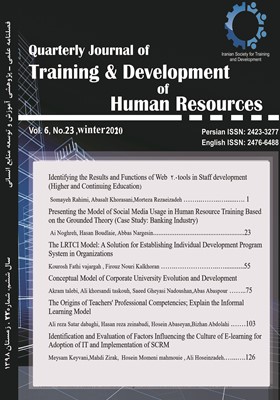Identification and evaluation of factors influencing the culture of E-learning for adoption of IT and implementation of SCRM
Subject Areas :میثم کیوانی 1 , Mehdi Zrak 2 , hossein momeni mahmouei 3 , Ali Hosseinzadeh 4
1 -
2 -
3 -
4 -
Keywords: Culture of E-learning, adoption of IT, Social customer relationship management (SCRM),
Abstract :
The purpose of this study was to identify and evaluate the effective factors of e-learning culture for IT adoption and SCRM deployment in Shargh Cement Company. The qualitative and objective research approach is a thematic exploratory study in which 25 managers of shargh cement and experts in this field were selected through semi-structured interviews through simple random sampling method. Findings The research identifies seven major themes, or factors, affecting e-learning culture for IT adoption and SCRM deployment. The seven themes are structural factors, behavioral factors, environmental factors, processes, outputs, effects and outcomes. 146 codes were extracted from these main themes in the context of the interviews.From these main themes, 75 concepts were extracted based on conceptual similarity, categorization, and composition. Then, the role of each of the subcategories in creating an e-learning culture for IT adoption and SCRM deployment was examined.
[1] Pavel, A. P., Fruth, A., & Neacsu, M. N. (2015). ICT and e-learning–catalysts for innovation and quality in higher education. Procedia Economics and Finance, 23, 704-711.
[2] Solangi,Z(2018). Factors affecting Successful Implementation of eLearning: Study of Colleges and Institutes Sector RCJ Saudi Arabia. Short Paper.1(3).223-230.
[3] Gahtani,S(2016). Empirical investigation of e-learning acceptance and assimilation: A structural equation model. Applied Computing and Informatics.12(3).27-50.
[4] King, R.B.; McInerney, D.M. & Watkins, D.A. (2012). “How you Think about your Intelligence determines how you feel in school: The Role of Theories of Intelligence on Academic Emotions”. Learning and Individual Differences, 22, 814–819.
[5] Greenberg,P(2010).CRM at speed of light ,Fourth Edtion Social CRM strategy ,Tools & Techniques For costumer,New york.Mc Grew.,
[6] Taylor, B. (2018). Board leadership: balancing entrepreneurship and strategy with accountability and control. Journal of Corporate Governance : The international journal of business in society, 3(2), 3-5.
[7] Kian, Maryam, Attaran, Mohammad, Fazeli, Nematollah (2011). Evaluating e-learning culture at Iranian universities: a fundamental theory concept. Iranian Society of Cultural and Communication Studies quartetly, 7(24), 95-127.
[8] Choi, S.K., Kwon, O.w.,&Kim, Y. K.(2017). Computer-assisted English learning system based on free conversation by topic. In K. Brothwick, L. Bradley & Thouseny,Call in a climate of change: adabting to turbulent global condination –short papers from EUORCALL 2017 . 79-85.
[9] Li, G., Lin, Y. and Yan, H.,(2019). Enhancing Agility by Timely Sharing of Supply Information, International Journal of Supply Chain Management,No. 11(5), PP. 425–435.
[10] Khan BH(2005). Managing e-learning: Design, delivery, implementation, and evaluation. Hershey, Pa: Information Science Publishing.
[11] Lian, J.W., Lin, T.M., (2018). Effects of consumer characteristics on their acceptance of online shopping: Comparisons among different product types, Computers in Human Behaviour, 24, 48–65.
[12] Rafeei, Masoumeh (2010). Investigating the factors affecting the professional development of employees at Islamic Azad University, Master’s thesis, Islamic Azad University, Lahijan Branch.
[13] Liu, S.-H., Liao, H.-L., & Peng, C.-J. (2005). Applying the Technology Acceptance Model and Flow Theory to Online E-learning Users' Acceptance Behavior. Issues in Information Systems, 6(2), 175-181.
[14] Morteza Akbari, Mohamad Alishahi (2018). Growth through innovation: management of technology-based businesses. Termeh publication.
[15] Byrd, T.A., Turner, E.T., (2018). An exploratory examination of the relationship between flexible IT infrastructure and competitive advantage. Information and Management 39, 41–52.
[16] Alberto carneir(2006).adopting new technologies. hand book or business strategy, pp 307-312.
[17] Hoseinjani, Abolfazl (2010). Role of e-learning in the improvement of human resources training in organizations, First national conference of research and education managers, Mashhad.
[18] Otarkhani, Ali (2008). Effects of IT and information systems on organizational relations. Tehran: Negah-e Danesh.
[19] Alkharang,M(2014). Factors that Influence the Adoption of e-Learning An Empirical Study in Kuwait.Phd Thesis. School of Information Systems Computing and Mathematics Brunel University.
[20] Chao. T., Saj. T & Tessier.F(2006) . Establishing a quality review for online courses: A formal review of online courses measures their qualities in key areas and reveals changes needed for improvement, if any. EDUCAUSE QUARTERLY number3.
[21] Goo Kim,Tae .Hyoung Lee,Jae .Law,Rob . (2018). An empirical examination of the acceptance behaviour of hotel front officesystems: An extended technology acceptance model. Tourism Management , 29, 500–513.
[22] Newton,D. Ellis,A(2019). A model for e-learning integration. Proceedings of World Conference on E-Learning in Corporate, Government, Healthcare, and Higher Education, Honolulu, Hawaii, October, Association for the Advancement of Computing in Education, Chesapeake, VA.
[23] Rym,B.Olfa,B.Melika,B(2013). Determinants of E-Learning Acceptance: An Empirical Study in the Tunisian Context. American Journal of Industrial and Business Management.3(43).307-321.
[24] Braun, V., & Clarke, V. (2006). Using thematic analysis in psychology. Qualitative Research in Psychology, 3(2), 77-101.


